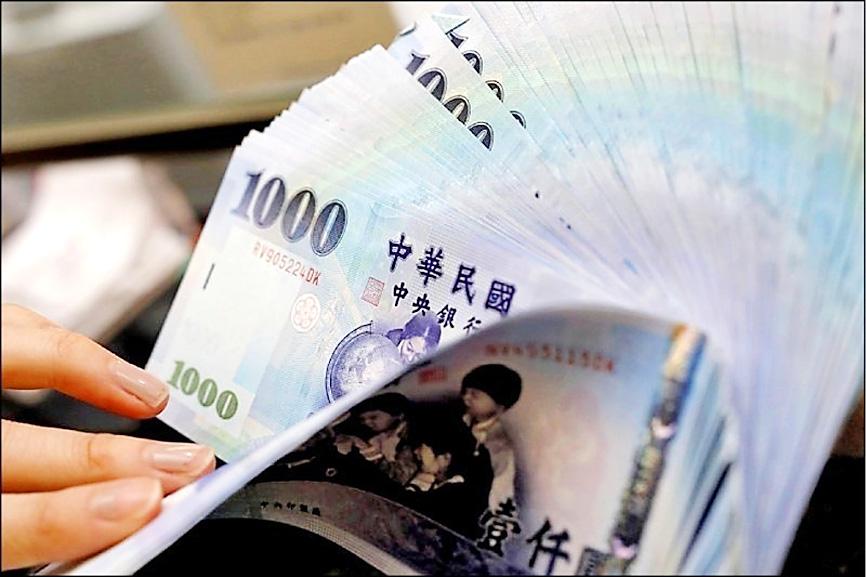Taiwan’s central bank yesterday urged the US to temporarily ease its monitoring of trading partners for currency manipulation during the ongoing COVID-19 pandemic.
The US Department of the Treasury should suspend its three criteria for designating major trading partners “currency manipulators” while the world battles the COVID-19, the central bank said in a statement on its Web site.
In its first foreign-exchange policy report on Friday last week, the administration of US President Joe Biden refrained from labeling any economy a currency manipulator, despite saying that Taiwan, Switzerland and Vietnam met the threshold.

Photo: Tyrone Siu, Reuters
The three criteria are having a trade surplus with the US of at least US$20 billion, a current account surplus exceeding 2 percent of GDP, and foreign-exchange interventions amounting to at least 2 percent of GDP.
Last year, Taiwan had a trade surplus of US$30 billion with the US, its account balance was 14.1 percent of GDP and its net foreign-exchange purchases amounted to about 5.9 percent of GDP.
The central bank said that it disagrees with the US applying the same model as used previously to determine whether the New Taiwan dollar is undervalued.
It also denied that Taiwan has sought to gain an unfair trade advantage by intervening in currency markets, saying that the free movement of large amounts of capital is the main cause of exchange-rate fluctuations and foreign-exchange transactions have little relevance to international trade.
The US on Friday said that it would initiate enhanced engagement with Taiwan to address what the report called the “structural undervaluation” of the NT dollar.
It also reiterated calls for Taiwan to refrain from intervening in foreign-exchange markets, except in exceptional circumstances.
It urged Taiwan to save less and invest more, including by encouraging consumption and building a stronger social safety net to help lower savings, “to diversify growth drivers away from exports” and “reduce the incentives to maintain an undervalued exchange rate.”
The last time Taiwan was named a currency manipulator by the US was in 1992.
On Friday, the Treasury Department said that it would engage with Taiwan, Switzerland and Vietnam to see if their actions constituted breaches of the Omnibus Trade and Competitiveness Act of 1988.
To be considered a currency manipulator, the US would also need to find, as required by the act, that a trading partner did so to prevent effective balance of payments adjustments or gain an unfair competitive advantage in trade.
The process to find evidence would continue, the report said.
Ireland and Mexico were added to the Treasury’s watch list, which means they met two of the three criteria for designation, while China, Thailand, India, Japan, South Korea, Germany, Italy, Singapore and Malaysia are on a monitoring list.
The agency said China’s “failure” to be more transparent around activities at state-owned banks warrants close monitoring. Those banks can act in currency markets with official guidance due to close relationships with China’s central bank.
“Treasury is working tirelessly to address efforts by foreign economies to artificially manipulate their currency values that put American workers at an unfair disadvantage,” US Secretary of the Treasury Janet Yellen said in a statement accompanying the report.

CHIP RACE: Three years of overbroad export controls drove foreign competitors to pursue their own AI chips, and ‘cost US taxpayers billions of dollars,’ Nvidia said China has figured out the US strategy for allowing it to buy Nvidia Corp’s H200s and is rejecting the artificial intelligence (AI) chip in favor of domestically developed semiconductors, White House AI adviser David Sacks said, citing news reports. US President Donald Trump on Monday said that he would allow shipments of Nvidia’s H200 chips to China, part of an administration effort backed by Sacks to challenge Chinese tech champions such as Huawei Technologies Co (華為) by bringing US competition to their home market. On Friday, Sacks signaled that he was uncertain about whether that approach would work. “They’re rejecting our chips,” Sacks

Taiwan’s long-term economic competitiveness will hinge not only on national champions like Taiwan Semiconductor Manufacturing Co. (TSMC, 台積電) but also on the widespread adoption of artificial intelligence (AI) and other emerging technologies, a US-based scholar has said. At a lecture in Taipei on Tuesday, Jeffrey Ding, assistant professor of political science at the George Washington University and author of "Technology and the Rise of Great Powers," argued that historical experience shows that general-purpose technologies (GPTs) — such as electricity, computers and now AI — shape long-term economic advantages through their diffusion across the broader economy. "What really matters is not who pioneers

BUBBLE? Only a handful of companies are seeing rapid revenue growth and higher valuations, and it is not enough to call the AI trend a transformation, an analyst said Artificial intelligence (AI) is entering a more challenging phase next year as companies move beyond experimentation and begin demanding clear financial returns from a technology that has delivered big gains to only a small group of early adopters, PricewaterhouseCoopers (PwC) Taiwan said yesterday. Most organizations have been able to justify AI investments through cost recovery or modest efficiency gains, but few have achieved meaningful revenue growth or long-term competitive advantage, the consultancy said in its 2026 AI Business Predictions report. This growing performance gap is forcing executives to reconsider how AI is deployed across their organizations, it said. “Many companies

TAIWAN VALUE CHAIN: Foxtron is to fully own Luxgen following the transaction and it plans to launch a new electric model, the Foxtron Bria, in Taiwan next year Yulon Motor Co (裕隆汽車) yesterday said that its board of directors approved the disposal of its electric vehicle (EV) unit, Luxgen Motor Co (納智捷汽車), to Foxtron Vehicle Technologies Co (鴻華先進) for NT$787.6 million (US$24.98 million). Foxtron, a half-half joint venture between Yulon affiliate Hua-Chuang Automobile Information Technical Center Co (華創車電) and Hon Hai Precision Industry Co (鴻海精密), expects to wrap up the deal in the first quarter of next year. Foxtron would fully own Luxgen following the transaction, including five car distributing companies, outlets and all employees. The deal is subject to the approval of the Fair Trade Commission, Foxtron said. “Foxtron will be